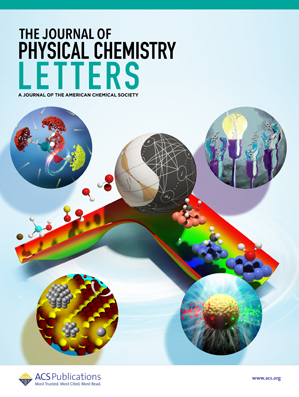Temperature Dependence of Photoinduced Carrier Spin Relaxation Dynamics in CsPbBr3 and MAPbBr3 Perovskite Quantum Dots
IF 4.6
2区 化学
Q2 CHEMISTRY, PHYSICAL
引用次数: 0
Abstract
Temperature dependent carrier spin relaxation dynamics of CH3NH3PbBr3 (MAPbBr3) and CsPbBr3 perovskite quantum dots (PQDs) have been studied at room temperature (RT), 150 K, and 77 K using spin selective femtosecond transient absorption (fs-TA) spectroscopy. Results reveal minimal temperature dependence in the MAPbBr3 PQDs with a lifetime of 2.2 ps. In contrast, the CsPbBr3 PQDs show strong temperature dependence, with the carrier spin lifetime increasing from RT (2.0 ps) to 150 K (11 ps) and to 77 K (57 ps). This behavior suggests the two PQD systems exhibit different carrier spin relaxation mechanisms. The dominant mechanism in CsPbBr3 PQDs is attributed to the Eliot–Yafet (EY) mechanism, modulated primarily by an electron–phonon interaction that is reduced at cryogenic temperatures. In contrast, for the MAPbBr3 PQDs the D’yakonov–Perel (DP) mechanism is dominant, likely due to broken inversion symmetry associated with the presence of MA, which induces a dynamical Rashba effect at finite temperature.

CsPbBr3和MAPbBr3钙钛矿量子点光诱导载流子自旋弛豫动力学的温度依赖性
利用自旋选择性飞秒瞬态吸收光谱(fs-TA)研究了CH3NH3PbBr3 (MAPbBr3)和CsPbBr3钙钛矿量子点(PQDs)在室温(RT)、150 K和77 K下的载流子自旋弛豫动力学。结果显示MAPbBr3 pqd的温度依赖性最小,寿命为2.2 ps。相比之下,CsPbBr3 pqd表现出强烈的温度依赖性,载子自旋寿命从RT (2.0 ps)增加到150 K (11 ps)和77 K (57 ps)。这表明两种PQD体系表现出不同的载流子自旋弛豫机制。CsPbBr3 PQDs的主要机制归因于艾略特-雅费(EY)机制,主要由电子-声子相互作用调制,该相互作用在低温下减少。相反,对于MAPbBr3 PQDs, D 'yakonov-Perel (DP)机制占主导地位,可能是由于与MA存在相关的反转对称性破坏,从而在有限温度下诱导动态Rashba效应。
本文章由计算机程序翻译,如有差异,请以英文原文为准。
求助全文
约1分钟内获得全文
求助全文
来源期刊

The Journal of Physical Chemistry Letters
CHEMISTRY, PHYSICAL-NANOSCIENCE & NANOTECHNOLOGY
CiteScore
9.60
自引率
7.00%
发文量
1519
审稿时长
1.6 months
期刊介绍:
The Journal of Physical Chemistry (JPC) Letters is devoted to reporting new and original experimental and theoretical basic research of interest to physical chemists, biophysical chemists, chemical physicists, physicists, material scientists, and engineers. An important criterion for acceptance is that the paper reports a significant scientific advance and/or physical insight such that rapid publication is essential. Two issues of JPC Letters are published each month.
 求助内容:
求助内容: 应助结果提醒方式:
应助结果提醒方式:


